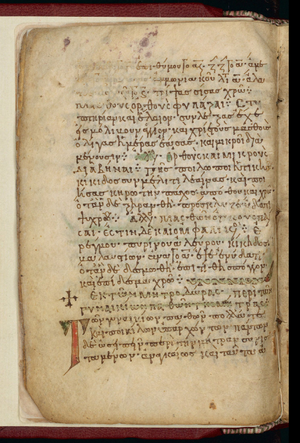Metrodora facts for kids
Metrodora (pronounced Mee-tro-DOR-uh) was likely the author of an ancient Greek medical book. This book was called On the Diseases and Cures of Women. She is known from only one very old book, called a manuscript.
This special manuscript is kept in the Laurentian Library in Florence, Italy. It's a collection of many medical writings. The first part of this collection is thought to be Metrodora's work. It mainly focuses on obstetrics, which is the care of women during pregnancy and childbirth, and other women's health topics.
If Metrodora was a real person, she would be one of only two ancient women whose medical writings have survived until today. The other is Cleopatra the Physician. We don't know exactly when Metrodora lived. Experts think she might have lived anywhere from the 1st to the 6th century AD. The latest she could have lived is when the Laurentian manuscript was created, around the 10th or 11th century. Even her name is debated! Some scholars think "Metrodora" might have been a fake name, or even a misunderstanding of the book's title.
About On the Diseases and Cures of Women
On the Diseases and Cures of Women is a medical book that has survived as part of a larger collection. This collection is found in a single manuscript, known as codex 75.3, at the Laurentian Library. This old book was made in the late 10th or early 11th century. It was likely put together in southern Italy.
The text was first published in 1945 by Aristotle Kousis. The surviving manuscript contains various writings about medical topics.
At some point, the Greek version of On the Diseases and Cures of Women was translated into Latin. But there was a mistake! It was wrongly said to be written by Cleopatra. This happened because one of the recipes in the book had a note saying Cleopatra used it. This Latin translation was published in 1566 by Caspar Wolf. Sadly, all copies of that Latin translation have been lost.
Who Was Metrodora?
We don't know much about Metrodora, if she was a real person. Experts have a few ideas about who she might have been:
- Metrodora was a medical writer whose writings were included in the Laurentian manuscript.
- Metrodora was the author of the first part of the manuscript. She might also have been the person who collected all the other writings in the book.
- "Metrodora" was actually the title of a book, and people later thought it was a person's name.
Along with Cleopatra the Physician, Metrodora is one of only two ancient women known to have medical writings that still exist. If she was a real person, we know she lived no later than the 10th or 11th century. This is when the Laurentian manuscript was put together. Many scholars believe she lived in the 6th century AD.
Some experts, like Kousis and Giorgiou del Guerra, think Metrodora lived in the 6th century. They base this on other writings found at the end of the Laurentian manuscript. However, other scholars, like Congourdeau, believe that only the first part of the manuscript is by Metrodora. This means the other writings don't help us figure out when Metrodora lived. Other experts suggest earlier dates. Ian M. Plant thinks Metrodora lived in the 2nd century AD. Holt Parker believes she lived between the 1st and 5th centuries. Irene Calà and Giulia Maria Chesi suggest she worked in Alexandria during the earlier part of this time.
Metrodora's Legacy

Metrodora has been remembered in modern times. She was included in Judy Chicago's famous art piece, The Dinner Party. Her name is on the Heritage Floor, near the place-setting for Hypatia.
There is a mural outside the Vall d'Hebron University Hospital in Barcelona, Spain. This mural shows many important women scientists from history, and Metrodora is one of them.
Two modern organizations are also named after Metrodora. The Metrodora Institute is a women's health clinic. Metrodora Ventures is a venture capital fund. This fund was started by Chelsea Clinton and invests in businesses related to health and education.
See also
 In Spanish: Metrodora para niños
In Spanish: Metrodora para niños


